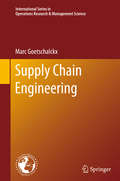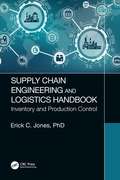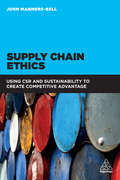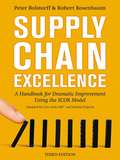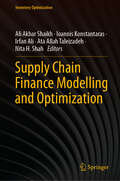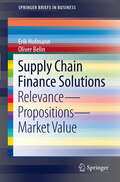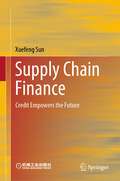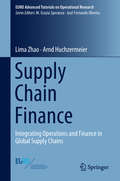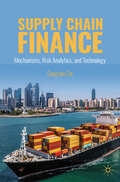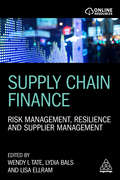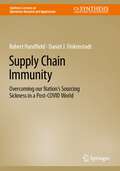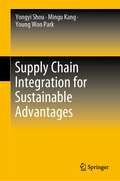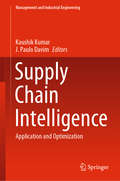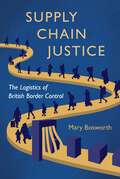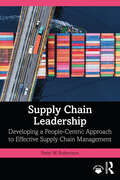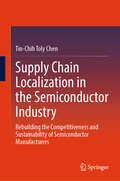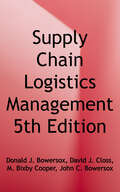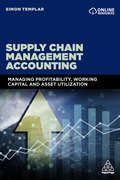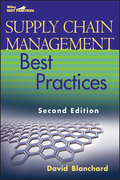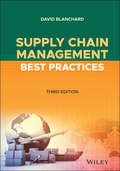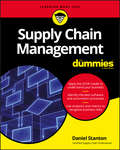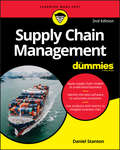- Table View
- List View
Supply Chain Engineering
by Marc GoetschalckxThe focus of Supply Chain Engineering is the engineering design and planning of supply chain systems. There exists a very large variety of supply chain system types, all with different goals, constraints, and decisions, but a systematic approach for the design and planning of any supply chain can be based on the principles and methods of system engineering. In this book, author Marc Goetschalckx presents material developed at the Georgia Tech Supply Chain and Logistics Institute, the largest supply chain and logistics research and education program in the world. The book can be roughly divided into four sections. The first section focuses on data management. Since most of planning and design requires making decisions today so that supply chain functions can be executed efficiently in the future, this section introduces forecasting principles and techniques. The second section of the book focuses on transportation systems. First, the characteristics of transportation assets and infrastructure are shown. Then four chapters focus on the planning of transportation activities depending on who controls the transportation assets. The third section of the book is focused on storing goods, and the last section of the book is focused on supply chain systems that consider simultaneously procurement, production, and transportation and inventory as well as the design of the supply chain infrastructure or network design. In each chapter, first a model of the process being studied is developed followed by a description of practical solution algorithms. More advanced material is typically described in appendices. This makes it possible to use an integrated, breath-first treatment of supply chain systems by using the initial material in each chapter. A more in depth treatment of a specific topic or process can be found towards the end of each chapter. End-of-chapter exercises are included throughout. This text is suitable for several target audiences. The first target is a course for upper-level undergraduate students on supply chains. The second target is the use in a capstone senior design project in the supply chain area. The third target is an introductory course on supply chains either in a master of engineering or a master of business administration program, and the final audience consists of students attending logistics or supply chain post-graduate or continuing education courses.
Supply Chain Engineering and Logistics Handbook: Inventory and Production Control
by Erick C. JonesThis handbook begins with the history of Supply Chain (SC) Engineering, it goes on to explain how the SC is connected today, and rounds out with future trends. The overall merit of the book is that it introduces a framework similar to sundial that allows an organization to determine where their company may fall on the SC Technology Scale. The book will describe those who are using more historic technologies, companies that are using current collaboration tools for connecting their SC to other global SCs, and the SCs that are moving more towards cutting edge technologies. This book will be a handbook for practitioners, a teaching resource for academics, and a guide for military contractors. Some figures in the eBook will be in color. Presents a decision model for choosing the best Supply Chain Engineering (SCE) strategies for Service and Manufacturing Operations with respect to Industrial Engineering and Operations Research techniques Offers an economic comparison model for evaluating SCE strategies for manufacturing outsourcing as opposed to keeping operations in-house Demonstrates how to integrate automation techniques such as RFID into planning and distribution operations Provides case studies of SC inventory reductions using automation from AIT and RFID research Covers planning and scheduling, as well as transportation and SC theory and problems
Supply Chain Ethics: Using CSR and Sustainability to Create Competitive Advantage
by John Manners-BellIt is increasingly clear that traditional supply chains which focus on sourcing products from the lowest possible cost suppliers are failing to exploit their full potential.Supply Chain Ethics, through case studies, surveys and unique research, identifies and outlines best practice being employed by global manufacturers, retailers and logistics companies. It examines the so-called 'triple advantage' that accrues to businesses when strategies that combine bottom line profits, sustainable environmental practices and positive societal impact are employed. Narrow supply chain strategies which focus on only one of these three factors will inevitably fail.Supply Chain Ethics covers the following issues which affect senior supply chain, operations and manufacturing managers: 'triple advantage' best practice and how it can create value for global businesses; product design; sourcing and warehousing; transportation and recycling; environmental practices of logistics companies and suppliers; supply chain technologies. There is also an invaluable Ethical Supply Chains survey of top global companies.
Supply Chain Excellence: A Handbook for Dramatic Improvement Using the SCOR Model
by Peter Bolstorff Robert RosenbaumThe Supply Chain Council (SCC) is a nonprofit organization dedicated to developing best practices in supply chain management. Now in a newly revised, second edition, Supply Chain Excellence is the first and only book on the DCOR, CCOR, and SCOR Models. It gives professionals implementing new supply chain projects a clear, step-by-step guide to adopting the accepted and proven methodologies developed by the SCC. This book shows readers how they can: * align strategy, material, workflow, and information * conduct the proper competitive analysis to define business opportunity * establish the metrics that will determine the project’s level of success * gain internal support by educating employees and executives Complete with new case studies, a Value Chain Excellence project roadmap, and the addition of the DCOR and CCOR process frameworks, the second edition of Supply Chain Excellence gives readers all the practical tools they need, whether they’re trying to improve the performance of an existing supply chain system or implement a new one.
Supply Chain Finance Modelling and Optimization (Inventory Optimization)
by Ata Allah Taleizadeh Nita H. Shah Ali Akbar Shaikh Irfan Ali Ioannis KonstantarasThis book provides a general overview of the use of optimisation techniques in decision-making concerning inventory problems, supply chain management, production and manufacturing management, problems related to vendor selection, transportation and logistics, and the use of fuzzy or interval techniques (uncertainty) in the aforementioned areas. It offers helpful guidance on how to decide which strategies to apply in different areas of real-world problems, especially highlighting latest advancements in supply chain management, inventory control, environmental planning, and optimisation. All authors have extensive research experience in practical decision-making scenarios which serves as the foundation for contributing chapters. The book thus assists scientists, upcoming researchers, and businesspeople in understanding optimisation techniques for finding the optimal answer to decision-making problems.
Supply Chain Finance Solutions: Relevance - Propositions - Market Value
by Erik Hofmann Oliver BelinThe book "Supply Chain Finance Solutions" offers orientation in the new discipline of Supply Chain Finance (SCF) by investigating the need for and nature of SCF, along with its characteristics and enablers. Due to the novelty of the Supply Chain Finance approach, there are still many knowledge gaps. This lack of research leads to uncertainties about the successful implementation of SCF solutions within companies as there is little quantified evidence on the achievable cost savings and other potential benefits. The authors close this gap by providing the latest information on business concepts and the SCF market. Based on a sample SCF model, the worldwide market size for such solutions and potential cost savings to companies engaged in SCF are analyzed. The work underlines the generally agreed-upon attractiveness and future relevance of SCF solutions by creating win-win situations; for all actors in the end-to-end supply chain as well as for external service providers.
Supply Chain Finance at Procter & Gamble
by David Lane Benjamin C. Esty E. Scott MayfieldIn April 2013, Procter & Gamble (P&G), the world's largest consumer packaged goods (CPG) company, announced that it would extend its payment terms to suppliers by 30 days. At the same time, P&G announced a new supply chain financing (SCF) program giving suppliers the ability to receive discounted payments for their P&G receivables. Fibria Celulose, a Brazilian supplier of kraft pulp, joined the program in 2013, but was re-evaluating the costs and benefits of participating in the SCF program in the summer of 2015. The firm's treasury group and its US country manager must decide whether to keep using the program and, if so, whether to keep their existing SCF banking relationship or start a new relationship with another global SCF bank.
Supply Chain Finance: Credit Empowers the Future
by Xuefeng SunThis book focuses on how supply chain finance serves and improves industrial supply chain and financial activities of SMEs in China from innovative perspective. How does supply chain finance empower SMEs? What is the basis for granting credit to SMEs? What kind of supply chain finance model can most effectively support SMEs? To address the above questions, this book adopts positivism, uses an inductive method and carries out case studies through qualitative analysis. At the end of book, the author concludes although many successful cases of supply chain finance could be found, it needs further testing and revision in practice for more enterprises due to its limits.
Supply Chain Finance: Integrating Operations and Finance in Global Supply Chains (Euro Advanced Tutorials On Operational Research)
by Arnd Huchzermeier Lima ZhaoThis textbook presents a coherent and robust structure for integrated risk management in the context of operations and finance. It explains how the operations-finance interface jointly optimizes material and financial flows under intricate risk exposures. The book covers financial flexibility, operational hedging, enterprise risk management (ERM), supply chain risk management (SCRM), integrated risk management (IRM), supply chain finance (SCF), and financial management of supply chain strategies. Both qualitative and quantitative approaches – including conceptualization, theory building, analytical modeling, and empirical research – are used to assess the value creation by integrating operations and finance. “This book provides a comprehensive description of the interactions between finance and operations and of how managers can best make decisions in recognition of these effects.” John R. Birge, University of Chicago“Supply chain finance is an emerging area where innovations can unlock great values to complement the advances in information and physical flows of supply chain.” Hau L. Lee, Stanford University“This book provides an excellent overview of supply chain finance and its most recent advances.” Jan A. Van Mieghem, Northwestern University“This book is indispensable for advanced students as well as practitioners when looking for a pedagogical sound and scientific rigorous approach to Supply Chain Finance.” Ralf W. Seifert, IMD/EPFL“The book advances our knowledge on the interface between operations and finance and provides managerial guidelines for effective risk management in the supply chain.” Xiande Zhao, CEIBS
Supply Chain Finance: Mechanisms, Risk Analytics, and Technology
by Gangshu CaiAs global supply chains become more complex, the need for expertise in their financial aspects grows. This book aims to equip students and professionals with the knowledge to navigate these complexities, ensuring efficient and resilient financial supply chain operations. It provides an in-depth exploration into the intricate and constantly evolving realm of supply chain finance. By merging key concepts, major mechanisms, hands-on risk analytics, and the latest technology trends, this book offers a seamless and comprehensive examination of the topic, grounded in the author's twenty years of academic research and hands-on experience. Students in supply chain management will gain a thorough understanding of the financial elements that are integral to modern supply chains, including the importance of liquidity, the role of financial institutions, and the optimization of cash flows within the supply chain ecosystem. Definitions will be used throughout the text to elucidate financial terminology that may be unfamiliar to management students. The instructor’s manual will include PowerPoint slides, exercises, and quizzes to assess student comprehension and progress. This textbook will serve as the primary resource for understanding the financial dimensions of supply chains.
Supply Chain Finance: Risk Management, Resilience and Supplier Management
by Dr Wendy Tate Prof. Dr Lydia Bals Lisa EllramSupply Chain Finance is a contributed book looking at the two major perspectives of managing finance across the supply chain. The first is more short-term, focused on accounts payables and receivables. The second is a more overarching perspective, focused on working capital optimization in terms of inventory and asset management. It includes chapters from a variety of research perspectives, as well as from business and policymakers. The authors look at the benefits of the supply chain finance approach including reduction of working capital, access to more funding at lower costs, risk reduction, as well as an increase of trust, commitment, and profitability through the chain.Supply Chain Finance includes theory as well as practical case studies addressing advances in the area of supply chain finance. The editors and contributors look at how to design and implement supply chain finance in supply chains and examine what the future holds for this important area. Online supporting resources include self-test multiple-choice and essay questions for each chapter.
Supply Chain Immunity: Overcoming our Nation’s Sourcing Sickness in a Post-COVID World (Synthesis Lectures on Operations Research and Applications)
by Robert Handfield Daniel J. FinkenstadtThis book provides a concerted supply chain perspective for dealing with pandemics on the scale of COVID-19. Specifically, this book describes a new approach, supply chain immunity, to illustrate what is needed to fix our economy and healthcare systems. The authors of this book are experts in supply chain management, health care supply chains, major systems acquisition, and contingency sourcing methods. Based on first-hand experiences working during COVID in the depths of the nation’s supply chain failures, the authors develop important themes for private and public sector supply chain managers to consider in rebuilding a more immune supply chain. The book is targeted at policy makers, academics, practitioners, and students of disaster response, public policy, healthcare, and supply chain management who are interested in learning contemporary lessons from the COVID-19 pandemic. From the perspective of those who lived through the chaos, the authors further explore the application of novel concepts in joint planning, market intelligence, and governance related to a national pandemic or other global contingency.
Supply Chain Integration for Sustainable Advantages
by Young Won Park Mingu Kang Yongyi ShouThis book offers a systematic literature review and a set of empirical studies on supply chain integration. Supply chain management is recognized as an essential means for firms to achieve competitive advantages, in which supply chain integration is regarded as the core for operational excellence: shorter lead time, lower inventory, faster delivery, and higher product and service quality. Using data from an international survey of manufacturing firms, an interrelated set of studies that investigate supply chain integration from different perspectives at multiple levels are conducted. Intra-organizational factors such as products, production systems, and socio-technical systems are examined to understand their effects on supply chain integration, indicating that firms need to implement different types of supply chain integration for specific competitive priorities. Then, the outcomes of supply chain integration, including its impact on risk management and sustainability management, are investigated from an inter-organizational perspective. The firm is embedded in a manufacturing network, a global supply chain, or both, and it can use supply chain integration as a strategic action for risks. Sustainability has been a vital issue for manufacturers, and supply chain integration can enhance its success. This book makes significant contributions to the relevant literature on supply chain integration and offers insights to supply chain managers in manufacturing industries.
Supply Chain Intelligence: Application and Optimization (Management and Industrial Engineering)
by J. Paulo Davim Kaushik KumarThe book provides an introduction to logistics and supply chain management and the application of evolutionary computation, focusing on specific fields related to supply chain issues, from strategic sourcing decisions, and production planning and control to inventory to logistics and its application using evolutionary / heuristics techniques. Bridging the gap between management research, decision-making and computer analysis, this interdisciplinary book features state-of-the-art descriptions of the corresponding problems and advanced methods for solving them.
Supply Chain Justice: The Logistics of British Border Control
by Mary BosworthHow the UK&’s immigration detention and deportation system turns people into monetized, measurable units on a supply chain In the UK&’s fully outsourced &“immigration detainee escorting system,&” private sector security employees detain, circulate and deport foreign national citizens. Run and organized like a supply chain, this system dehumanises those who are detained and deported, treating them as if they were packages to be moved from place to place and relying on poorly paid, minimally trained staff to do so. In Supply Chain Justice, Mary Bosworth offers the first empirically grounded, scholarly analysis of the British detention and deportation system. Drawing on four years of extensive ethnographic research, Bosworth examines what keeps the system in place and whether it might be effectively challenged.Told by a senior manager that &“this is a logistics business,&” Bosworth documents how the public and private sectors have built a supply chain in which people&’s humanity is transformed both symbolically and tangibly through administrative processes and bureaucracy into monetized, measurable units. Like all logistics, the system has failure built into it. The contract does not seek to eradicate risk but rather to manage it, determining responsibility and apportioning a financial value to such &“failures&” as delay, escape, aborted flight or death in custody. Front-line workers and managers depoliticise and normalise their efforts by casting their duties in familiar bureaucratic terms, with targets, &“service level agreements&” and &“key performance indicators.&” Focusing on first-hand accounts from workers and lengthy observation and document analysis, Bosworth explores the impact of border logistics in order to ask what it would take to build inclusive infrastructures rather than those designed to exclude.
Supply Chain Leadership: Developing a People-Centric Approach to Effective Supply Chain Management
by Peter W. RobertsonSupply chain leaders are key to achieving sustainable supply chain excellence and long-term competitive advantage. This book addresses ‘big-picture’ supply chain leadership and provides a roadmap and practical advice to help supply chain leaders to successfully navigate this challenging social and technical environment. The book describes crucial leadership characteristics and explains the actions necessary to develop and appraise the skills in both new and existing leaders. It presents a socio-technical framework, which includes the key aspects of supply chain relationships, the supply chain business environment, overall supply chain competitiveness, supply chain sustainability, and supply chain risks. The book works through the recruitment, training, and development of leaders as well as obstacles and risks, to offer a fresh, people-centred approach. Pedagogy to aid learning is incorporated throughout, including an introduction to each chapter explaining the key learnings; tables, diagrams, and equations to help visualise the concepts and methods covered; real-life case studies and examples; and end of chapter review questions and assignment tasks. This textbook should be essential reading for advanced undergraduate and postgraduate students of supply chain, logistics, and operations management. The practice-based and applied approach also makes it valuable for operating supply chain leaders and those studying for professional qualifications. Online resources include chapter-by-chapter PowerPoint slides, a test bank of exam questions, and suggested tutorial topics.
Supply Chain Localization in the Semiconductor Industry: Rebuilding the Competitiveness and Sustainability of Semiconductor Manufacturers
by Tin-Chih Toly ChenThis book provides a comprehensive exploration of semiconductor supply chain localization, offering insights into the formulation of effective strategies and ways to enhance the competitiveness and sustainability of semiconductor manufacturers through supply chain localization. The semiconductor industry is currently witnessing a significant localization wave, with a growing trend of wafer foundries relocating their production capacity closer to chip designers. This shift is primarily driven by factors such as the US-China trade war, geopolitical considerations, the impact of Covid-19, the Russia-Ukraine conflict, and the increasing importance of environmental awareness. By localizing semiconductor supply chains, companies can effectively address these challenges while also improving their competitive edge and ensuring long-term sustainability in the face of political and war risks. However, achieving supply chain localization in the semiconductor industry is a complex endeavor, as traditional factors considered in semiconductor supply chain management may no longer be decisive. Moreover, existing research on the subject is often scattered across various journal issues and conference proceedings, necessitating a systematic integration of these findings. Furthermore, most of the available supply chain management-related books do not specifically focus on this topic. This book aims to bridge these gaps by providing a comprehensive resource that combines relevant references, real-world cases, and supporting evidence.
Supply Chain Logistics Management
by Donald J. Bowersox David J. Closs M. Bixby Cooper John C. BowersoxThis book presents Logistics in the context of integration within a firm's Supply Chain Strategy and Operations. The framework of Supply Chain Management is initially presented by creating a foundation for in-depth study of the five logistics operational components in Part Two. Challenges and strategies related to design and operational integration of logistics within a global supply chain are discussed in Part Three. Part Four focuses on administrative challenges related to cross organizational collaboration, performance measurement, and concludes with the challenges of managing risk and achieving sustainability. An essential feature of the overall presentation is the integration of topical materials and examples into the Supply Chain Logistics value creation process. Text materials are supported by study and challenge questions as well as contemporary cases. The presentation integrates the discussion of information technology throughout. Illustrations and examples highlight how firms deal with operational challenges and use logistics performance to gain competitive advantage.
Supply Chain Logistics: Foundational Knowledge
by Leo Reddy Rebekah HuttonGlobal Supply Chain Logistics, The Logistics Environment, Material Handling Equipment, Safety Principles, Safe Material Handling & Equipment Operation, Quality Control Principles, Work Communication, Teamwork & Good Workplace Conduct to Solve Problems, Using Computers.
Supply Chain Logistics: Mid-level Technical Knowledge
by Leo Reddy Rebekah HuttonSupply Chain Logistics: Mid-Level Technical Knowledge
Supply Chain Management Accounting: Managing Profitability, Working Capital and Asset Utilization
by Simon TemplarThe need to contain costs across the business is as strong as ever and the search for cost reduction opportunities is intensifying. There still remains one last major opportunity to take out costs - through the supply chain. Ultimately all costs will make their way to the final marketplace to be reflected in the price paid by the end user. Smart companies instead seek to make the supply chain more competitive through the value it creates and the costs it reduces overall. They have realised that the real competition is not company against company but rather supply chain against supply chain.Supply Chain Management Accounting looks at how the evolution of supply chains has been dramatic over the last few years, with more and more companies moving to sourcing overseas, distributing finished goods to overseas markets, and increasing their international operations. The seeking of low-cost country sourcing, optimizing manufacturing, and exporting products and services has created new challenges to demand forecasting and supply chain planning. Supply Chain Management Accounting presents a wide range of approaches and ground-breaking research findings. The book covers profitability, liquidity and asset utilisation, product costing, activity-based costing, investment appraisal, customer profitability analysis, budgeting and sales and operations planning. Online supporting resources include invaluable study questions and worked solutions to reinforce the learning as well as multiple-choice questions with solutions and PowerPoint activities.
Supply Chain Management Best Practices
by David BlanchardLearn what it takes to develop and have a "best-in-class" supply chain This new edition shows you how to build supply chains that work by illustrating how leading companies are doing it. Identifying world-class supply chains in more than a dozen different industries and explaining in detail how these companies got to where they are, this essential book reveals the proven strategies, solutions, and performance metrics used by leading companies to design their extended enterprises. Identifies proven strategies, solutions, and performance metrics for supply chain management best practice benchmarks Shows how to manage supply chains in a global marketplace and how to choose third-party providers New edition includes new chapters on green supply chains and lean supply chains, and expanded analysis of emerging technologies Includes coverage of supply chain metrics, planning and forecasting, procurement, manufacturing, transportation, globalization, customer service, collaboration, security, and workforce management Written by the Editorial Director of Penton Media's Supply Chain Group and a Contributing Editor to IndustryWeek magazine It also offers guidance on the latest technology, green supply chains, going lean, how to choose third-party logistics providers, and how to manage the supply chain in a global environment.
Supply Chain Management Best Practices
by David BlanchardLearn from leaders across industries to develop a tech-enabled "best-in-class" supply chain Supply Chain Management Best Practices, Third Edition, is the long-awaited update to a classic resource. Since the second edition was published, the demands of the marketplace have radically shifted the dynamics of supply chain management. Transportation and fulfillment must now accommodate the technological gains that have transferred computing power from mainframes and workstations into smartphones in hands around the world. This updated book covers the new concepts, processes, and technologies that today’s supply chain professionals must know—including drones, the Internet of Things, same-day delivery, artificial intelligence, and more. Award-winning author David Blanchard discusses how companies are actively using these technologies and gaining competitive advantage through their implementation. Like its predecessors, this edition focuses on industry trends and case studies, offering the stories, recent examples of supply chain initiatives, and insights into new best practices. You'll learn proven methods for measuring the performance of a supply chain, including traditional core processes and new, extended strategies being used by today’s leading companies. Identifies proven strategies, solutions, and performance metrics for supply chain management best practices Shows how to manage supply chains in a global marketplace and how to choose third-party providers Includes new coverage of today’s game-changing supply chain technologies: drones, the Internet of Things, same-day delivery, omni-channel distribution, artificial intelligence, Uber-style freight transportation apps, blockchain, robotics, and more Discusses supply chain metrics, planning and forecasting, procurement, manufacturing, transportation, distribution, globalization, customer service, risk management, supply chain finance, and workforce management This invaluable guide for supply chain professionals, CFOs, CIOs, and others, also offers guidance on green supply chains and managing logistics in a global environment.
Supply Chain Management For Dummies
by Daniel StantonEveryone can impact the supply chain Supply Chain Management For Dummies helps you connect the dots between things like purchasing, logistics, and operations to see how the big picture is affected by seemingly isolated inefficiencies. Your business is a system, made of many moving parts that must synchronize to most efficiently meet the needs of your customers—and your shareholders. Interruptions in one area ripple throughout the entire operation, disrupting the careful coordination that makes businesses successful; that's where supply chain management (SCM) comes in. SCM means different things to different people, and many different models exist to meet the needs of different industries. This book focuses on the broadly-applicable Supply Chain Operations Reference (SCOR) Model: Plan, Source, Make, Deliver, Return, and Enable, to describe the basic techniques and key concepts that keep businesses running smoothly. Whether you're in sales, HR, or product development, the decisions you make every day can impact the supply chain. This book shows you how to factor broader impact into your decision making process based on your place in the system. Improve processes by determining your metrics Choose the right software and implement appropriate automation Evaluate and mitigate risks at all steps in the supply chain Help your business function as a system to more effectively meet customer needs We tend to think of the supply chain as suppliers, logistics, and warehousing—but it's so much more than that. Every single person in your organization, from the mailroom to the C-suite, can work to enhance or hinder the flow. Supply Chain Management For Dummies shows you what you need to know to make sure your impact leads to positive outcomes.
Supply Chain Management For Dummies
by Daniel StantonIncrease your knowledge of supply chain management and leverage it properly for your business If you own or make decisions for a business, you need to master the critical concept of supply chain management. Supply Chain Management For Dummies, 2nd Edition guides you to an understanding of what a supply chain is and how to leverage this system effectively across your business, no matter its size or industry. The book helps you learn about the areas of business that make up a supply chain, from procurement to operations to distribution. And it explains the importance of supporting functions like sales, information technology, and human resources. You’ll be prepared to align the parts of this system to meet the needs of customers, suppliers, and shareholders. By viewing the company as a supply chain, you’ll be able to make decisions based on how they will affect every part of the chain. To help you fully understand supply chains, the author focuses on the Supply Chain Operations Reference (SCOR) model. This approach allows all types of professionals to handle their work demands. • Use metrics to improve processes • Evaluate business risks through analytics • Choose the right software and automation processes • Plan for your supply chain management certification and continuing education A single business decision in one department can have unplanned effects in one or more areas, such as purchasing or operations. Supply Chain Management For Dummies helps you grasp the connections between business lines for wiser decision making and planning.
